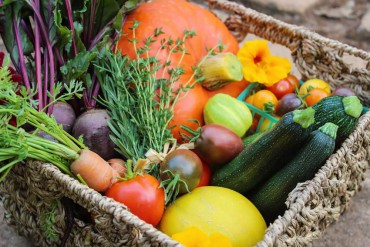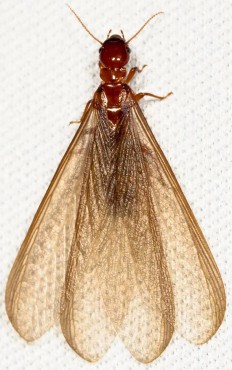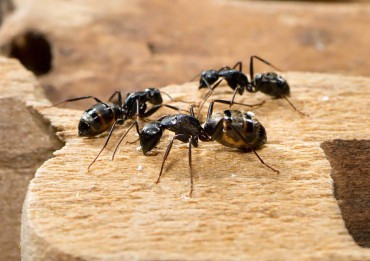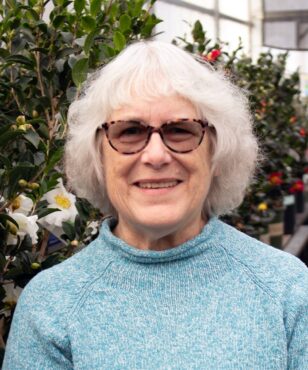 Fall Harvesting
Fall Harvesting
September and October are a time for pause and reflection and also new beginnings. It’s a time to celebrate the bounty in our gardens and to harvest and preserve fruits, vegetables and herbs for later enjoyment. If you have extra produce, remember to take it to local food banks for others to enjoy.
Freezing Veggies
Every fall I pick, harvest, blanch and freeze the carrots and beans I plant each year in a rotation. We enjoy them all winter long and into the spring. One year, I even froze beet greens and kale.
The possibilities are endless. See nchfp.uga.edu/how/freeze/blanching.html for good information on how to prepare and freeze vegetables plus a handy chart for guidance.
Drying Herbs
Drying herbs from the garden is thought to be one of the easiest (i.e. user friendly) ways to preserve savory seasonings grown at home. Some gardeners even freeze herbs in ice cube trays if they have room in their freezers.
Visit nchfp.uga.edu/how/dry/herbs.html to read about several different ways to dry herbs. NCHFP stands for National Center for Home Food Preservation. It’s a research-based network that provides information to the public on how to safely process food for later use.
Time to Plant and Relocate
Fall is a good time of year to purchase a few new additions for your gardens. Bulbs come in now for November through January planting. Also purchase woody plants such as shrubs and trees. Remember to water them well at planting and every few weeks during winter if we don’t get the usual seasonal rains.
It’s also a great time to put in some native plants. Visit the Buck Lake Native Plant Garden in Hansville to see native plants in a landscaped garden setting. Some are purely natives and others are cultivars of native plants. You’ll find lots of ideas at this garden. It’s also a lovely area for a picnic and for a walk along the trails.
Fruit trees and berry bushes are often planted this time of year too. Check out the local fruit society tastings, usually offered in October. There is now a fruit club on Bainbridge Island in addition to the Peninsula Fruit Club.
Evergreen shrubs and dormant woody plants can ideally be moved to other locations or dug up and divided this time of year. I have plans to move several rhodies, some hydrangeas, a rose and a few woody shrubs in late October or early November.
I’ll also be digging up, dividing and moving several humongous oriental irises that are hogging up space in perennial beds that are too small. Luckily I’ve mapped out new locations in my garden for all these soon to be relocated plants.
If you’d like to relieve your garden of some plants, the Plant Salvage Team from the Master Gardener Foundation of Kitsap County will come to your property and dig up and divide plants you no longer wish to keep. If you only want to divide up and share the plants, they’ll replant what you wish left behind.
If you belong to a garden club that raises funds to donate back to the community, contemplate sharing some of your gardens’ floriferous bounty for a good cause. If you don’t belong to a garden club, please contact the Plant Salvage Team through the Master Gardener Foundation of Kitsap County. You’ll be glad you did.
Become a Master Gardener
The WSU Kitsap Extension Master Gardener Training Course begins in January each year. But October is the time for filling out an application and attending the orientation meeting. Call the Extension office or register online to receive information about attending the orientation and information session.
Classes are in person and online and there’s often an option to take the training at a higher cost and participate in it without becoming a volunteer.

Termite
Carpenter Ants, Moisture Ants and Termites
During early spring into summer and again in fall, carpenter ants, moisture ants and termites sprout wings and begin flying about to find a future home for the queens and their expanding colonies. If these wood-chewing critters head to the forests and fields, there’s nothing to worry about. But if they’re seen in abundance near the foundations of your homes or in wood piles too close to your home, you’ll want to take a closer look.
Several times a year, check woodpiles, decks, sheds, outbuildings, foundations of your home and underneath your home, especially in the crawl spaces. To check for carpenter ants, look for piles of sawdust, the result of chewing and tunneling. Also look for frass (digestive waste droppings commonly known as poop).
For termites, look for mud tubes and tunnels. Remember to monitor or eliminate areas where moisture accumulates. Moist wood can serve as an inviting temptation to wood-destroying pests.
All these insects congregate near water and moisture sources. Rotting wood is especially appealing to them. Carpenter ants can sometimes be heard gnawing inside wall cavities. It’s also said that termites can be heard gnawing. Definitely not a good thing.
Our region is home to two types of termites — Pacific dampwood termites and subterranean termites.
Subterranean termites are those to be most concerned about because they not only favor damp wood, but also dry wood. They also like areas with loamy soil profiles and the Kitsap Peninsula has quite a few areas with these conditions.
See the sidebar link for a map of these areas. For further information or to provide locations where subterranean termites have been discovered, you can also contact Dr. Dan Suomi at the WSU Puyallup research center, dsuomi [at] agr [dot] wa [dot] gov or 360-902-2044.
The preceding paragraphs are the bad news but the good news is these insects rarely take up residence in or under homes. They want to live out in the forests and fields, not in our homes.

Carpenter ants don’t actually eat the wood but they do gnaw through and into it to chew off bites of wood for nesting materials. They like decayed wood better than good wood. Termites are more destructive but you’ll see signs of their presence and can take measures to eliminate them or prevent them from setting up house under your home.
To tell the difference between ants and termites, notice their body shape. Termites’ wings are much longer. Their bodies are flatter and their color is different. Some have black heads but their bodies are reddish brown.
Invading carpenter ants are most often coming from the main colony. You can often see the trails (under an inch wide) leading back to their main home colony. Sometimes they’ve set up house in wood piles located near your home. Make sure woodpiles stay dry and well away from the house to prevent carpenter ant habitat.
Moisture ants are usually much smaller than carpenter ants and their body shapes are different. Their colors range from yellow to black. Moisture ants are not a huge problem but can be an indicator of future problems, especially if not removed from the rotting wood areas under and around homes.
WSU publication EB1382 states, “These ants are not a primary structural pest, but they can speed the deterioration of wood. They also become a nuisance as they enter homes in search of food. If possible, determine where the ants are coming from.
“These ants require moisture to survive. They may be nesting in damp soil outside or under the house, beneath sidewalks, along foundations or under debris and rocks in the yard. Or, the ants may be living in damp, decaying wood. If the ants are nesting in wood, they may throw out sawdust as they enlarge their nests.”





























